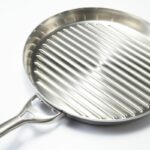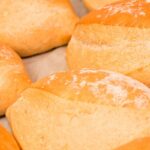When choosing a ceramic plate, there can be certain specifications that you might have.

One example could be for the ceramic plate to be oven proof – something that might come in handy for warming plates before meals, reheating certain dishes with ease, or simply using it to hold messy foods during cooking.
But this begs the question: are ceramic plates oven safe, and how can you be sure?
Are Ceramic Plates Oven Safe?
Most ceramic plates and cookware are oven safe up to a point, but you should not make a blanket assumption about this.
While most cookware can resist the heat of the oven, this change in temperature should still be gradual, so as to avoid causing the plate to crack or other forms of damage that could occur.
Even ceramic plates can be put in the oven, although this should generally be kept at lower temperatures, and should likewise be gradual to avoid damage.
How To Check For Oven Safety?
The easiest way to check that ceramic plates are oven safe is to look on the bottom. Most modern products will have a symbol on the underside of the plate that indicates whether or not the product is oven safe.
If the product in question does not have that symbol, then chances are they are not suitable for extended periods in a hot oven.
Other Ways To Check
Another way to check this is to look in the manual or literature that came with the plate or dish.
This will undoubtedly have the information you need regarding your product’s oven safe status, and can be a useful guide to avoiding cracks, breakages, and other damage to your plates.
You can also base your decision based on the brand of the product. Some brands are known for their oven safety, and have it as a standard attribute amongst all of their products.
If this is the case, then you can probably safely use them in the oven. However, it is always best to double check.
You could also check on the manufacturer’s website. This serves a similar purpose as the manual with the product, and can be a good way to either contact the company themselves, or hunt down the relevant information pertaining to your issue.
Why Are Ceramics Good Against Heat?
Generally speaking though, most ceramic products can withstand more height than those of other materials – something that makes them handy for all manner of jobs around the home and the wider world.
They Are Durable
Firstly, ceramic products are generally more durable than other materials such as glass or pottery. This makes them a handy product for the kitchen, where all manner of accidents can occur during use.
Can Withstand Heat
Due to the materials used to make ceramics, and the process through which they are fired, they have a much higher capacity for heat than similar products.
This makes them suited to cooking, as it means they can withstand the heat of enclosed heating systems like an oven without breaking under the pressure.
Can Ceramics Break From Heat?
While ceramic plates and dishes can withstand much more heat than other materials, they can still break under the heat if not used correctly.
This generally happens when there are sudden changes in temperature – i.e. when the ceramic plate goes from cold to intensely hot within a short time frame.
This can cause the ceramic to crack and shatter, creating a mess and ruining your meal. It could also cause damage to your oven, especially if the ceramic shatters violently.
How Hot Is Too Hot?
Generally speaking, well fired ceramic products can withstand temperatures of around 1000 degrees fahrenheit – and in fact some can even surpass that limit.
This obviously means that in a traditional oven it is very hard to cause damage to ceramics – however, as mentioned above, this does not mean that it isn’t possible.
How To Avoid Damaging Ceramics
As such, there are a few ways to ensure you do not cause undue damage to your ceramic products or your oven.
Increase Heat Gradually
As mentioned above, it is important to increase the heat of ceramic plates gradually, so as to avoid the sudden changes in temperature that can cause cracks and breakages.
By allowing the temperature to creep up slowly, this ensures that the shock of the temperature change does not damage the ceramic.
Decrease Heat Gradually
Likewise, if you remove the plate from the oven, you also need to allow it to cool gradually as well. This means that you shouldn’t drop a hot ceramic plate directly into freezing cold water, or else reap the benefits that extreme heat changes can cause.
Don’t Preheat Oven
With this need for gradual temperature change, you should also not preheat the oven before use. This is because adding a cold ceramic plate into a fully heated oven will give too much of a shock and cause the plate to crack or become damaged.
By putting a cold plate in a cold oven, and allowing them to increase in temperature together gradually, you stand a much higher chance of avoiding damage and breakages.
Can Other Ceramic Products Go In Oven?
While it is unlikely for you to do so, you can also put other ceramic products in an oven – including mugs, cups, and other dishes not designed for the oven.
Final Thoughts
And there we have it, everything you need to know about ceramic plates, and how to tell if they are oven proof.
It’s true that choosing the right ceramic container or plate can be difficult – especially if you have specific requirements for food preparation.
However, there have never been more options for those looking for the right product – not to mention the number of resources to help you double check.
So if you want to know whether your ceramic plate is oven proof, then be sure to follow these methods!
- How To Reheat A Cheesesteak - November 5, 2023
- What Are Three Must Have Kitchen Knives? - September 22, 2023
- How To Protect Edges Of Pie Crust - June 15, 2023








